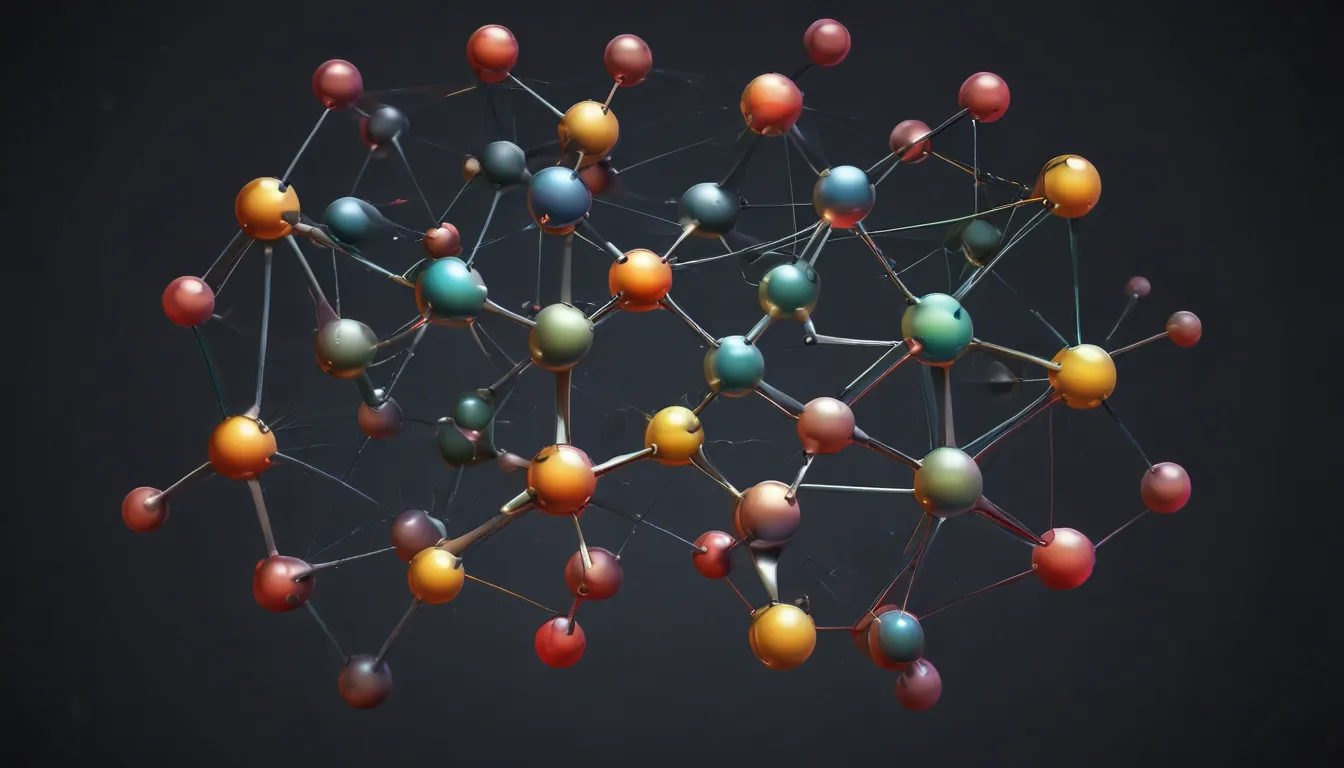A Note About Images: The images used in our articles are for illustration purposes only and may not exactly match the content. They are meant to engage readers, but the text should be relied upon for accurate information.
Are you intrigued by the captivating world of chemistry? Have you ever found yourself mesmerized by the intricate dance of atoms and molecules? If so, chances are you’ve encountered the concept of Lewis dot structure in your studies. Lewis dot structure offers a visual depiction of the valence electrons of an atom or molecule, allowing us to unravel the mysteries of their chemical behavior. In this enlightening article, we will delve into 14 intriguing facts about Lewis dot structures that will enrich your appreciation for their role in the realm of chemistry. From the foundational principles of electron configuration to the complexities of resonance structures, get ready to embark on a journey to uncover the secrets behind these fascinating diagrams. So, without further ado, let’s explore the captivating world of Lewis dot structures!
Understanding the Essence of Lewis Dot Structure
- Lewis Dot Structure is a visual tool that illustrates how atoms bond in molecules through the use of dots and lines.
- It enables us to comprehend how atoms share electrons to form chemical bonds, acting as a key to deciphering the enigmas of chemical bonding.
The Genesis of Lewis Dot Structure
Gilbert N. Lewis, an American chemist, introduced the concept of Lewis Dot Structure in 1916, revolutionizing the understanding of chemical bonding.
His pioneering work has left a lasting impact on the field of chemistry, paving the way for simplified representations of molecular structures.
Deciphering Valence Electrons with Dots
In a Lewis Dot Structure, the valence electrons of an atom are symbolized by dots positioned around the atomic symbol, providing a straightforward means of determining the number of valence electrons.
This visual representation facilitates the visualization of electron distribution within molecules, shedding light on their bonding patterns.
Unveiling the Octet Rule
The octet rule stipulates that atoms strive to attain a configuration of eight valence electrons through gaining, losing, or sharing electrons.
Lewis Dot Structure acts as a guide to elucidate how atoms achieve this stable electron configuration, laying the groundwork for understanding chemical bonding.
Mapping Molecular Bonding
The central atom in a Lewis Dot Structure is delineated by its atomic symbol, encompassed by dots representing its valence electrons.
Subsequent atoms are connected to the central atom using lines, symbolizing the bonds formed between them.
Delving into Bonding Pairs and Lone Pairs
In addition to bonding pairs, Lewis Dot Structure encompasses non-bonding pairs of electrons, portrayed by pairs of dots adjacent to the atomic symbol.
These lone pairs play a crucial role in shaping the molecule’s geometry and influencing its reactivity.
Unraveling Double and Triple Bonds
Upon sharing more than one pair of electrons, atoms form double or triple bonds, which are represented by multiple lines in the Lewis Dot Structure.
These multiple bonds are instrumental in determining the strength and stability of molecular interactions.
Envisioning Molecular Geometry
By analyzing the Lewis Dot Structure of a molecule, one can predict its three-dimensional shape or molecular geometry, offering insights into its physical and chemical properties.
This predictive capability is essential in unraveling the behavior and characteristics of various compounds.
Illuminating Chemical Reactions
Lewis Dot Structure serves as a valuable tool for chemists to analyze and forecast the interactions between different atoms and molecules.
It provides a comprehensive understanding of the mechanisms underlying the formation and dissolution of chemical bonds.
Embracing Lewis Dot Structure in Education
Widely utilized in introductory chemistry courses, Lewis Dot Structure acts as an essential educational aid, simplifying the comprehension of chemical bonding for students.
It serves as a foundational stepping stone for budding chemists, fostering a deeper appreciation for the intricacies of molecular structures.
Bridging the Gap: Organic and Inorganic Molecules
From simple organic compounds to complex inorganic structures, Lewis Dot Structure transcends boundaries, offering a universal framework to depict bonding arrangements and valence electron distributions.
Its versatility extends across diverse molecular structures, enriching the understanding of chemical bonding principles.
Navigating Molecular Polarity
By scrutinizing the electron distribution in a molecule’s Lewis Dot Structure, one can discern its polarity status, distinguishing between polar and nonpolar molecules.
This knowledge unlocks a deeper understanding of the physical and chemical properties exhibited by various substances.
Embracing Resonance Structures
In scenarios where a molecule can manifest multiple valid Lewis structures, the concept of resonance comes into play.
Resonance structures offer alternative representations of a molecule, contributing to its overall stability and reactivity.
Pioneering Electron-Dot Diagrams with Lewis Dot Structure
Electron-dot diagrams, synonymous with Lewis Dot Diagrams, provide a simplified portrayal of the valence electron arrangement in atoms and molecules.
Lewis Dot Structure serves as the cornerstone for crafting accurate electron-dot diagrams, facilitating a clearer visualization of electron distribution.
Embarking on a Journey of Discovery
In conclusion, Lewis dot structures stand as a cornerstone of chemistry, unveiling the intricate dance of electrons in the outermost energy level of atoms.
Through our exploration of 14 captivating facts about Lewis dot structures, we’ve delved into the art of interpreting these structures and comprehending their pivotal role in shaping molecular landscapes. Moreover, we’ve uncovered their applications in diverse realms of chemistry, spanning from organic chemistry to biochemistry. Whether you’re a novice embarking on a voyage through the wonders of chemistry or a seasoned professional seeking to deepen your insights, mastering Lewis dot structures opens doors to a profound understanding of molecular geometry, polarity, and chemical reactivity. By honing this foundational concept, you equip yourself with a powerful tool to analyze and predict the behavior of molecules with precision. So, continue your odyssey through the captivating realm of chemistry, allowing Lewis dot structures to guide you in unraveling the enigmatic properties of the elements and compounds that surround us.
FAQs: Unveiling the Mysteries of Lewis Dot Structure
-
What is a Lewis dot structure?
A Lewis dot structure is a graphical representation of the valence electrons in an atom or molecule, employing dots or crosses to depict electrons and dashes to signify bonds. -
Why are Lewis dot structures important?
Lewis dot structures play a pivotal role in visualizing electron distribution within molecules, enabling an understanding of their bonding patterns and reactivity. -
How do you draw a Lewis dot structure?
To draw a Lewis dot structure, calculate the total number of valence electrons, disperse them as dots around the symbol for each atom, and establish connections between atoms through single, double, or triple bonds based on available valence electrons. -
What does a lone pair represent in a Lewis dot structure?
A lone pair denotes a pair of electrons that remains unbound to other atoms, influencing the shape and reactivity of a molecule. -
Are Lewis dot structures the same as electron dot structures?
Yes, Lewis dot structures and electron dot structures refer to the identical concept of representing valence electrons using dots or crosses. -
Can Lewis dot structures be utilized for all molecules?
Lewis dot structures are applicable to most covalent molecules and certain ionic compounds, primarily aiding in understanding the distribution of electrons within molecules. -
How do Lewis dot structures aid in understanding molecular shapes?
By assessing the number of electron groups (lone pairs and bonded atoms) surrounding a central atom, Lewis dot structures offer insights into the molecular geometry and the presence of bond angles or distortions. -
Can Lewis dot structures prognosticate chemical reactions?
While Lewis dot structures alone may not forecast specific reactions, they provide a fundamental understanding of molecular reactivity. By scrutinizing electron distribution and bond types, chemists can anticipate potential reactions a compound might undergo.
Embark on a Journey of Exploration
Mastering the art of Lewis dot structure serves as a foundation for comprehending complex concepts in chemistry, providing a gateway to delve into the realms of molecular geometry, polarity, and chemical reactivity. Whether you’re a curious novice or a seasoned aficionado of chemistry, our captivating journey through 14 intriguing facts about Lewis dot structures has illuminated the path to unraveling the mysteries of the molecular world. For those yearning to deepen their knowledge further, our comprehensive guide on Lewis structures offers a plethora of captivating facts that build upon the foundational principles covered here. Embrace the wonders of chemistry, allowing Lewis dot structures to serve as your compass in navigating the boundless realms of chemical intricacies.
Experience the Wealth of Knowledge
Our dedication to delivering authentic and engaging content remains steadfast in our commitment to fostering a community of learners and explorers. Each fact shared on our platform is a product of real user contributions, enriching our collective knowledge with diverse insights and information. To uphold the highest standards of accuracy and reliability, our dedicated editors diligently review each submission, ensuring that the facts we impart are not only intriguing but also credible. Place your trust in our unwavering commitment to quality and authenticity as you embark on a journey of discovery and learning with us.






